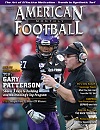Article CategoriesAFM Magazine
|
Speed Report: Progression Training – Critical for Processing Football Speedby: Dale BaskettFootball Speed Specialist © More from this issue What really is progression training? Progression is a word we can use in many ways. I use the word to describe an element that must be utilized within the structure of football speed training. When we set up a plan for training throughout the year, we need to progress the skill level and proficiency demands as time and training moves forward. The plan advances the structure to a step-by-step development process. The goal is to end the training season in the preferred position to begin in-season with maximum speed and movement effectiveness. All football players need a progressive development structure.
|
|
|||||||
| HOME |
MAGAZINE |
SUBSCRIBE | ONLINE COLUMNISTS | COACHING VIDEOS |
Copyright 2025, AmericanFootballMonthly.com
All Rights Reserved





